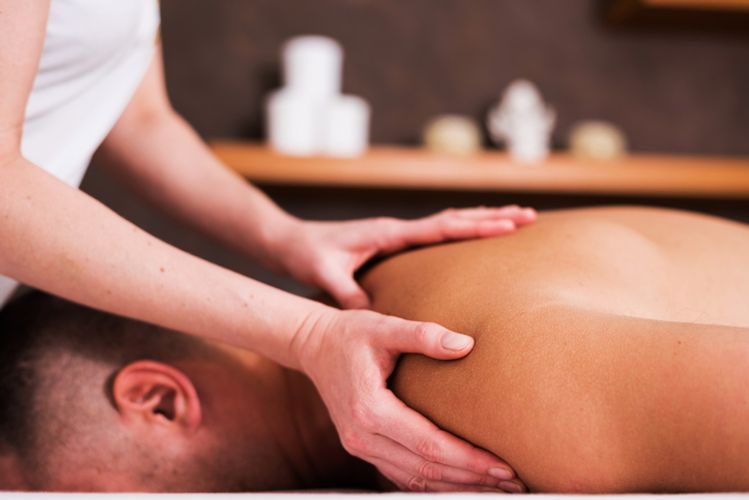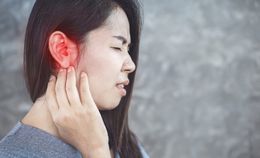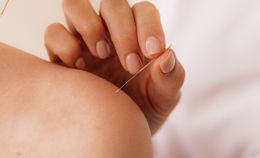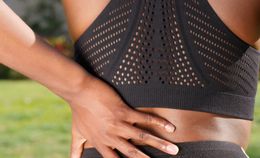- Poor posture: Desk jobs can promote long hours slouching and hunching, which can result in sharp pains in the neck and shoulders.
- Muscle strain from unusual activity: Let's say you took up a friend on an invitation to go rock climbing. Or spent a day moving around pavers in the backyard for a landscaping project. Or repainted a ceiling. If you're not a frequent rock climber, landscaper or painter, any of these activities may result in sore muscles for days afterward.
- Arthritis: Osteoarthritis describes what happens when cartilage and other tissues in a joint break down over time. Cartilage cushions bones and nerves in your joints. As cartilage thins, this leads to increased friction of bones and nerves in the joint during movement, causing inflammation, stiffness, and pain.1
- Shoulder impingement syndrome/rotator cuff tendinitis: These terms both help describe the same condition in which the acromion, part of your shoulder blade, pinches the rotator cuff, the group of muscles and tendons surrounding the shoulder joint, when a person lifts their arms or moves them overhead. (Tendinitis describes the inflamed tendons;2 impingement describes the narrowing of space between bone and soft tissue.) This causes pain in the front or back of the shoulder and sometimes radiating down the arm, and pain when reaching behind the back. Another common symptom is weakness in the arm or shoulder, especially when the arms are lifted overhead.3
- Rotator cuff injury: The most common symptom of an injured rotator cuff is dull, aching shoulder pain. Many patients also complain of more severe pain if they turn onto the injured shoulder while sleeping. Rotator cuff injuries are most often suffered by athletes (e.g. swimmers, tennis players, baseball players), and by people whose work involves spending hours reaching overhead.4
- Surgery: Shoulder surgeries can lead to lengthy recovery periods. During recovery, the patient may experience not only the post-surgical pain at the site of an incision, but also develop compensatory movement patterns to minimize their use of the painful shoulder, resulting in pain elsewhere in the body.5
- Frozen shoulder (also called adhesive capsulitis): This is a challenging long-term condition caused by thickened connective tissue in the shoulder. It occurs most often in people with severely restricted shoulder mobility over a long period (during recovery from a broken arm, surgery or stroke, for example). Older people and patients with diabetes, Parkinson's, and certain other diseases are also at increased risk. Frozen shoulder develops slowly and is characterized by increasing pain and stiffness with any shoulder movement until mobility becomes extremely limited. Frozen shoulders can "thaw" - but full recovery usually takes years.6
How Shoulder Massage Can Help
It is a safe and effective way to relieve shoulder pain from all of its most common causes, although certain conditions require special care.
Massage therapy increases blood circulation, relaxes tense muscles, helping to increase flexibility and restore range of motion to stiff and painful muscles and joints. This can ease the pain of impingement in the shoulder by releasing muscle tension behind the poor posture causing the impingement, or muscle tension causing the impingement directly. Massage can also help relieve the pain of tendinitis by lengthening and stretching muscles and tendons to relieve pressure.7
Massage can help relieve arthritis pain in the shoulder by reducing muscle tension on the joint. (For acute cases of arthritis or in very old and frail patients, massage may pose some risks, so a doctor should be consulted before a massage therapy treatment program is started).
Massage therapy can also aid in breaking down scar tissue after surgery,8 to help restore range of motion and support successful recovery. Massage can also aid surgery patients with relief from stress and anxiety they may be experiencing as part of their injury or illness and medical treatment.9 If you are recovering from surgery, you should discuss with your doctor when massage therapy would be a safe and beneficial addition to your recovery plan.
Trigger point therapy, Shiatsu, and deep tissue massage techniques can aid people suffering from shoulder pain caused by sports injuries and overuse. These techniques apply deep pressure to tight muscle knots, acupressure points, and soft tissue throughout the shoulder for effective release of muscle tension and stiffness. These techniques can help jumpstart mobility to facilitate the client continuing with self-care methods at home, such as stretching exercises, for maximum impact.
What to expect at your first shoulder massage
What to expect at your first shoulder massage varies depending on the type of massage you have booked.
Swedish massage is generally considered a gentler and more relaxing experience than trigger point therapy, Shiatsu (Japanese acupressure massage), deep tissue, or sports massage. However, many massage clients credit the latter types of massage with providing effective relief of pain and stiffness caused by muscle tension, even if the massage experience itself can feel more "intense" at times than Swedish massage technique.
Swedish massage involves stroking, rhythmic kneading, and percussive motions - what most people think of when they think of massage therapy. Trigger point therapy involves applying significant, sustained, focused finger pressure to tight muscle knots until they dissipate, sometimes for as long as a minute.
Shiatsu massage also involves sustained pressure on specific points of the body, but usually for much shorter periods. In this case, the points are acupressure points and the goal is the free flow of qi, or energy, in the body to support holistic health according to principles of traditional Chinese medicine. In Shiastu massage, finger pressure on acupressure points is combined with pressure from the palms in a rhythmic sequence.10
It's likely your massage therapist will be familiar with a variety of techniques and they should work with you and communicate openly in order to best serve your specific needs. Talk to your massage therapist about your symptoms and ask questions about their training and the techniques they plan to use. Don't hesitate to provide feedback during the massage - some temporary, mild discomfort during a massage is normal, but discomfort should never be unpleasantly intense.
Other health benefits of shoulder massage
Massage has many recognized and increasingly well-documented health benefits well beyond localized pain relief - although that alone can be reason enough to book a massage, as any pain sufferer knows.
Massage helps decrease psychological symptoms that often go hand-in-hand with pain, such as depression and anxiety.11 Massage can help relieve stress12 and facilitate better sleep.13 The psychological benefits of massage are so notable that massage therapy is increasingly being used to ease symptoms of a variety of mental health conditions, including PTSD,14 anxiety experienced by people undergoing invasive medical treatment (such as surgery and chemotherapy),15 and those in hospice care.
So don't be surprised if you leave a shoulder massage feeling better mentally - or by some unexpected physical benefits! Massages to one part of the body can sometimes have surprising effects elsewhere in the body.
That's because massage can treat referred pain. Referred pain is pain felt in one location that is caused by something happening elsewhere in the body - for example, pain felt in the fingers might be caused by a shortened, tight muscle in the arm.16 For this reason, if you're feeling achy, sore, or stiff, a full body massage is never a bad idea, as every part of your body is connected.
Similarly, a massage to a specific location of the body, like the shoulder, can sometimes offer surprising relief of pain and tension elsewhere also.
The Bottom Line
If you are experiencing shoulder pain or discomfort, consult with your doctor to determine what might be causing it. For most common conditions, massage is a safe and effective treatment option for short-term relief of pain, stiffness, and discomfort.
A regular massage therapy program can play a valuable role in injury recovery and prevention. And, since massage therapy offers many other health benefits, getting a regular shoulder massage can go a long way to support your overall wellness.
References:
1 "Shoulder Osteoarthritis: Diagnosis and Management": https://www.aafp.org/afp/2008/0901/p605.html
2 "What You Need to Know About Rotator Cuff Tendinitis": https://www.healthline.com/health/rotator-cuff-tendinitis
3 "Shoulder Impingement": https://health.usf.edu/~/media/Files/Medicine/Orthopaedic/SMART/Patient%20Education/shoulder%20impingement.ashx
4 "Rotator Cuff Injury": https://www.mayoclinic.org/diseases-conditions/rotator-cuff-injury/symptoms-causes/syc-20350225
5 "Helping Patients After Surgery": https://www.amtamassage.org/articles/3/MTJ/detail/3834/helping-patients-after-surgery
6 "Frozen Shoulder": https://www.mayoclinic.org/diseases-conditions/frozen-shoulder/symptoms-causes/syc-20372684
7 "When is Massage Appropriate for Shoulder Pain?": https://www.integrativehealthcare.org/mt/when-is-massage-appropriate-for-shoulder-pain/
8 "Massage + Orthopedic Pathologies": https://www.amtamassage.org/articles/3/MTJ/detail/3887/massage-orthopedic-pathologies
9 "Helping Patients After Surgery": https://www.amtamassage.org/articles/3/MTJ/detail/3834/helping-patients-after-surgery
10 "Massage Therapy for Back and Neck Pain": https://www.verywellhealth.com/massage-for-neck-and-back-pain-89164
11 "Massage Therapy + Mental Health": https://www.amtamassage.org/articles/1/News/detail/2930/massage-therapy-mental-health
12 "Massage Therapy Can Relieve Stress": https://www.amtamassage.org/about/position-statements/massage-therapy-can-relieve-stress/
13 "Research Literacy: Massage and Sleep": https://www.amtamassage.org/publications/massage-therapy-journal/research-massage-sleep/
14 "In Safe Hands: Massage & PTSD": https://www.amtamassage.org/articles/3/MTJ/detail/3484/in-safe-hands-massage-ptsd
15 "Massage Therapy for Cancer Patience": https://www.amtamassage.org/resources/massage-and-health/medical-treatments/massage-for-cancer-patients/
16 "Understanding Referred Pain":https://elementsmassage.com/elm-grove/blog/understanding-referred-pain





















